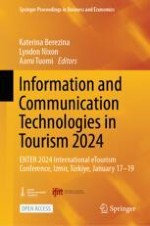
Open Access 2024 | OriginalPaper | Buchkapitel
Exploring the Impact of Music in Short-Form Travel Videos on Users’ Emotional Resonance, Sharing Intention and Impulsive Travel Intention
verfasst von : Kaige Zhu, Jiao Li, Han Zhou, Juhyeok Jang
Erschienen in: Information and Communication Technologies in Tourism 2024
Verlag: Springer Nature Switzerland
Aktivieren Sie unsere intelligente Suche, um passende Fachinhalte oder Patente zu finden.
Wählen Sie Textabschnitte aus um mit Künstlicher Intelligenz passenden Patente zu finden. powered by
Markieren Sie Textabschnitte, um KI-gestützt weitere passende Inhalte zu finden. powered by